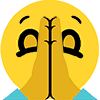Watch
Events
Articles
Market
More
BIBLE STUDY LESSON 14
SERIES T --- THE ADONAI OF LIFE
THE CROSS
YESHUA IS CRUCIFIED
From Matthew 27:35-56; Mark 15:24-41; Luke 23:33-49; John 19:18-30
With one criminal at His left and another at His right, Yeshua was crucified on a hill called Golgotha, which meant, {The Skull.} Yeshua prayed, [Abba, forgive them; for they do not know what they are doing.] Beneath the cross the Roman soldiers divided Yeshua’ clothing into four parts, one part for each of them. But they decided to throw dice for His cloak, for it was seamless, and they did not want to tear it. This fulfilled the prophecy, [They divided My clothing and cast lots for My cloak.] Yeshua was crucified about nine o’clock in the morning. Pilate had a sign nailed on His cross that read, [Yeshua of Nazareth, King of the Jews,] written in Hebrew, Latin and Greek. The chief priests and rulers had argued with Pilate, [Don’t call Him the King of the Jews! Say instead that He claimed to be the king of the Jews.] But Pilate responded, [What I have written, I have written!] Some of the people near the cross shook their heads and ridiculed Yeshua. [You thought You could destroy the temple and rebuild it in three days! If You are YHVH’s Son, come down from the cross and save Yourself.] The chief priests and rulers also mocked Yeshua. [He saved others, but He cannot save Himself. If He is the King of Israel, let Him come down from the cross and we will believe in Him. He trusted YHVH; why doesn’t YHVH deliver Him? Did He not claim to be YHVH’s Son?] One of the robbers who was crucified with Yeshua joined in the mockery. [If You are the Son of YHVH, save Yourself and us,] he chided. But the other robber rebuked the first. [Don’t you, a condemned criminal, fear YHVH? We deserve to die because of our crimes, but this Man does not, for He has done nothing wrong.] This man turned to Yeshua and said, [Yeshua, remember me when You come into Your Kingdom.] Yeshua replied, [I promise that you will be with Me today in paradise.] Standing near Yeshua’ cross were His mother, His mother’s sister, Mary the wife of Cleopas and Mary Magdalene. When Yeshua saw His mother standing with John, He said to her [John is now your son,] and to John He said, [She is now your mother.] From that time on, Mary went to live in John’s home. From noon until three o’clock that afternoon, darkness came across the entire land. About three o’clock, Yeshua cried out with a loud voice, [Eloi, Eloi, lama sabachthani?] which meant, [My YHVH, My YHVH, why have You forsaken Me?] Some thought He called for Elijah to come to rescue Him. Yeshua recognized that the work He had come to do on the cross was almost finished, so He cried out, [I thirst!] Someone dipped a sponge in a vessel filled with vinegar, and put it on a reed to lift it to His mouth. [Stop! Let’s see first if Elijah comes to rescue Him,] said some others. When the vinegar was given to Yeshua, He cried out with a loud voice, [It is finished! Father into Your hands I commit My Spirit.] When He said this, He died. The veil of the temple, separating the Holy Place and the Holy of Holies, was torn from top to bottom, the earth shook, and rocks split. Tombs opened and many godly men and women arose from the dead. After Yeshua arose from the dead, these people left the cemetery and appeared to many people in Jerusalem. When the centurion and his men, who had guarded Yeshua, saw the earthquake and other amazing signs, they were frightened. [This Man certainly was the Son of YHVH,] they said. There were a number of women present at Yeshua’ crucifixion, watching from a distance. They had followed Yeshua from Galilee, ministering to Him. Among them were Mary Magdalene, Mary the mother of James and Joseph, and the mother of James and John, sons of Zebedee.
COMMENTARY
GOLGOTHA
The Gospels say that Yeshua was crucified on a hill outside the walls of Jerusalem, but the precise location of the spot remains unsettled. The disagreement centres on two different places. The Church of the Holy Sepulchre has been honoured as the site of the crucifixion for many hundreds of years. But some have raised doubts that the rock underneath the church’s altar is truly part of the bill of Golgotha, and point to another location that is not in the heart of the Old City. Outside the walls of modern Jerusalem, a short distance from the Damascus Gate, another bill was noticed in the nineteenth century. This hill matches the description in the Bible. [Golgotha] is related to a word that means {skull,} and the skull-shaped rock with its nearby tomb seems to confirm the belief that this is the place of Yeshua’ death and burial. Most historians and archaeologists, however, still accept the Church of the Holy Sepulchre as the correct location. It has been identified as the area of Yeshua’ death by an ancient believer’s tradition that goes back to before the second century. Only ten years after Yeshua’ death, Herod Agrippa enlarged the walls of Jerusalem. The new wall included the hill of Golgotha within its boundaries. But the site was not built upon because it was considered unclean by the Jews as a former place of execution, and holy by the believers as the place of Yeshua’ crucifixion. If the believers marked the spot in some way, later events destroyed it. Two Jewish rebellions against the Romans brought double destruction to the city. To prevent further rebellions, the emperor Hadrian expelled the Jews from Jerusalem in 135 A.D. Because the early believers were Jewish by birth, they were included in the ban. When at last they were able to return, they found that Hadrian had built a temple to Roman gods over the place where Golgotha once stood. Hadrian’s temple covered Golgotha for two hundred years. During that time, the believers passed the knowledge of the hill’s location from one generation to the next. Not until 335 A.D. was the hill of Golgotha uncovered. Constantine, the first believing emperor, decided to tear down the pagan temple and build a church on the scene of Yeshua’ great sacrifice. The builders discovered that Golgotha had not been levelled; it was only covered and surrounded by loose dirt. The site was enshrined beneath the Church of the Holy Sepulchre where today it can be seen -- and touched -- through an opening in a silver disc on the church floor.


